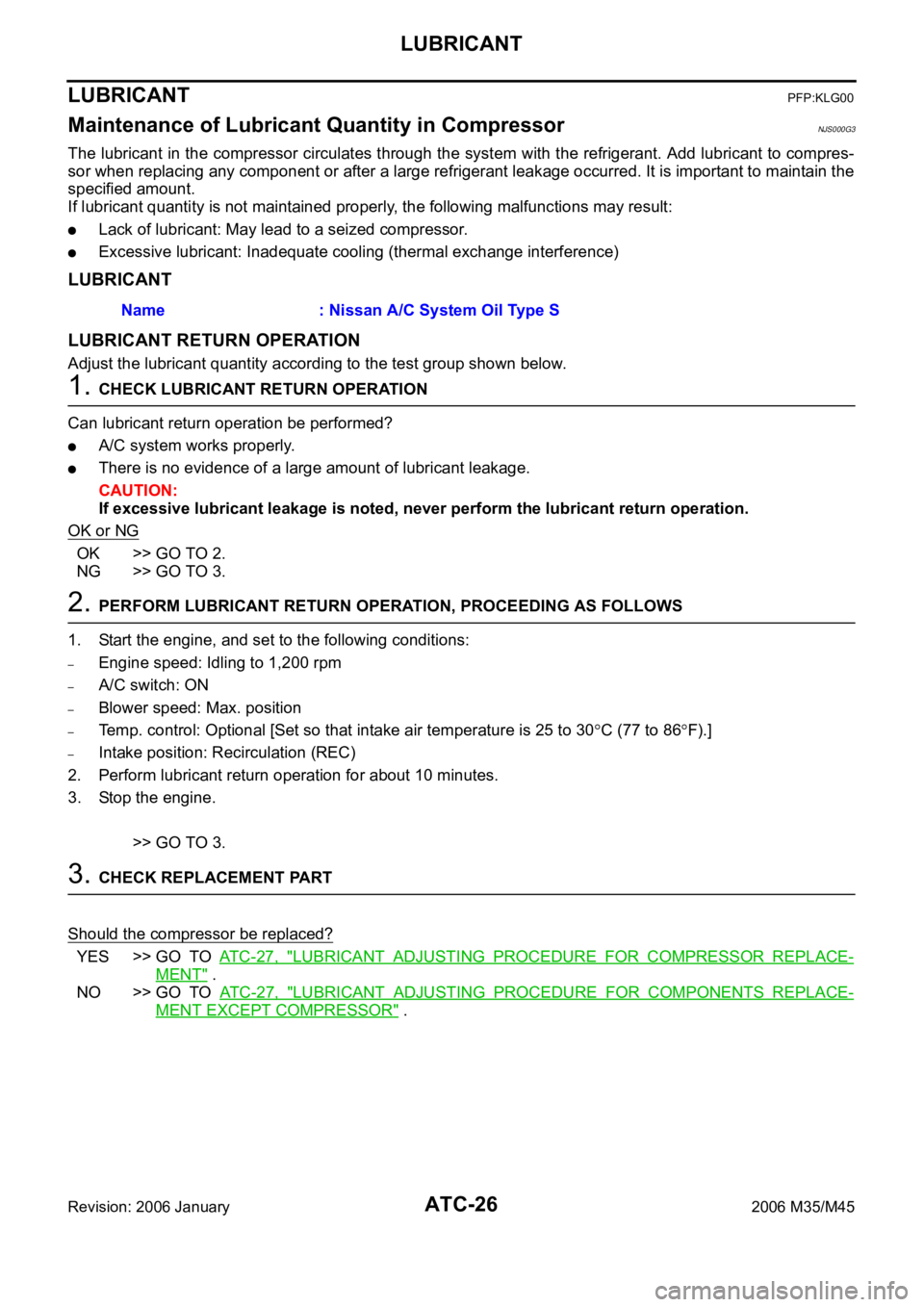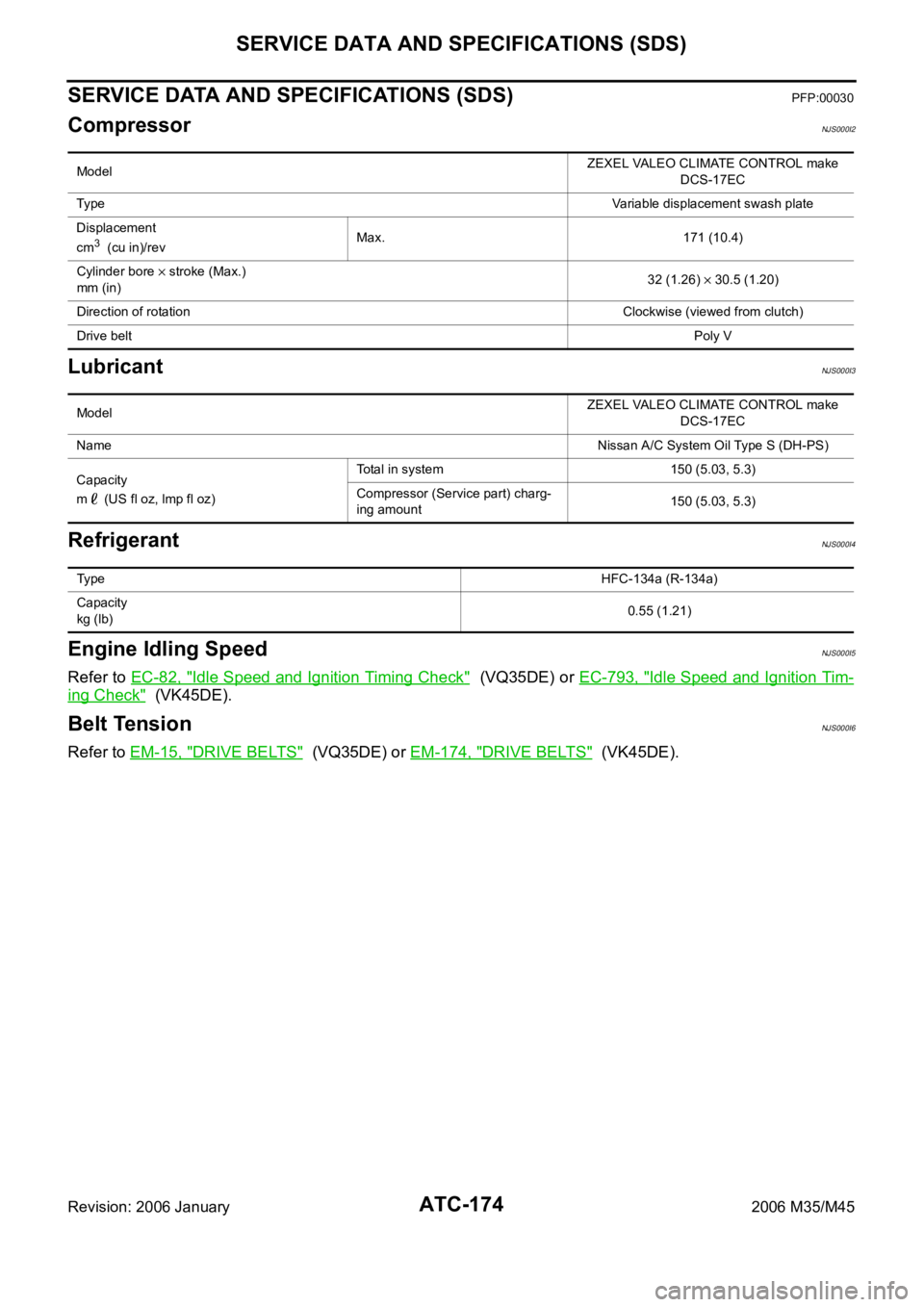refrigerant type INFINITI M35 2006 Factory Service Manual
[x] Cancel search | Manufacturer: INFINITI, Model Year: 2006, Model line: M35, Model: INFINITI M35 2006Pages: 5621, PDF Size: 65.56 MB
Page 448 of 5621

ATC-1
AUTOMATIC AIR CONDITIONER
J AIR CONDITIONER
CONTENTS
C
D
E
F
G
H
I
K
L
M
SECTION AT C
A
B
AT C
Revision: 2006 January2006 M35/M45
AUTOMATIC AIR CONDITIONER
PRECAUTIONS .......................................................... 5
Precautions for Supplemental Restraint System
(SRS) “AIR BAG” and “SEAT BELT PRE-TEN-
SIONER” .................................................................. 5
Precautions Necessary for Steering Wheel Rotation
After Battery Disconnect .......................................... 5
OPERATION PROCEDURE ................................. 5
Precautions for Procedures without Cowl Top Cover ..... 6
Precautions for Working with HFC-134a (R-134a) ..... 6
CONTAMINATED REFRIGERANT ....................... 7
General Refrigerant Precautions .............................. 7
Precautions for Refrigerant Connection ................... 7
ABOUT ONE-TOUCH JOINT ................................ 7
FEATURES OF NEW TYPE REFRIGERANT
CONNECTION .................................................... 10
O-RING AND REFRIGERANT CONNECTION ... 10
Precautions for Servicing Compressor ................... 12
Precautions for Service Equipment ........................ 13
RECOVERY/RECYCLING EQUIPMENT ............ 13
ELECTRICAL LEAK DETECTOR ....................... 13
VACUUM PUMP ................................................. 13
MANIFOLD GAUGE SET .................................... 13
SERVICE HOSES ............................................... 14
SERVICE COUPLERS ........................................ 14
REFRIGERANT WEIGHT SCALE ...................... 14
CHARGING CYLINDER ...................................... 14
Precautions for Leak Detection Dye ....................... 15
IDENTIFICATION ................................................ 15
IDENTIFICATION LABEL FOR VEHICLE ........... 15
PREPARATION ......................................................... 16
Special Service Tools ............................................. 16
HFC-134a (R-134a) Service Tools and Equipment ... 17
Commercial Service Tools ...................................... 19
REFRIGERATION SYSTEM ..................................... 20
Refrigerant Cycle ................................................... 20
REFRIGERANT FLOW ....................................... 20
FREEZE PROTECTION ..................................... 20
Refrigerant System Protection ............................... 20
REFRIGERANT PRESSURE SENSOR ............. 20
PRESSURE RELIEF VALVE ............................... 20Variable Displacement Compressor ....................... 21
GENERAL INFORMATION ................................. 21
DESCRIPTION .................................................... 22
Component Layout ................................................. 25
LUBRICANT .............................................................. 26
Maintenance of Lubricant Quantity in Compressor ... 26
LUBRICANT ........................................................ 26
LUBRICANT RETURN OPERATION .................. 26
LUBRICANT ADJUSTING PROCEDURE FOR
COMPONENTS REPLACEMENT EXCEPT
COMPRESSOR .................................................. 27
LUBRICANT ADJUSTING PROCEDURE FOR
COMPRESSOR REPLACEMENT ....................... 27
AIR CONDITIONER CONTROL ............................... 29
Description of Air Conditioner LAN Control System ... 29
System Construction .............................................. 29
OPERATION ........................................................ 30
TRANSMISSION DATA AND TRANSMISSION
ORDER ............................................................... 30
AIR MIX DOOR CONTROL (AUTOMATIC TEM-
PERATURE CONTROL) ..................................... 31
FAN SPEED CONTROL ...................................... 31
INTAKE DOOR CONTROL ................................. 31
MODE DOOR CONTROL ................................... 31
UPPER VENTILATOR DOOR CONTROL .......... 31
MAGNET CLUTCH CONTROL ........................... 32
SELF-DIAGNOSIS SYSTEM .............................. 32
Description of Control System ................................ 33
Control Operation ................................................... 33
DISPLAY SCREEN .............................................. 33
MULTIFUNCTION SWITCH ................................ 34
DISPLAY SCREEN .............................................. 34
MODE SWITCH (DRIVER SIDE) ........................ 34
MODE SWITCH (PASSENGER SIDE) ................ 34
TEMPERATURE CONTROL SWITCH (POTEN-
TIO TEMPERATURE CONTROL) (DRIVER
SIDE) ................................................................... 34
TEMPERATURE CONTROL SWITCH (POTEN-
TIO TEMPERATURE CONTROL) (PASSEN-
GER SIDE) .......................................................... 34
Page 453 of 5621

ATC-6
PRECAUTIONS
Revision: 2006 January2006 M35/M45
Precautions for Procedures without Cowl Top CoverNJS000FP
When performing the procedure after removing cowl top cover, cover
the lower end of windshield with urethane, etc.
Precautions for Working with HFC-134a (R-134a)NJS000FQ
CAUTION:
CFC-12 (R-12) refrigerant and HFC-134a (R-134a) refrigerant are not compatible. If the refrigerants
are mixed and compressor malfunction is likely to occur, refer to “CONTAMINATED REFRIGER-
ANT” below. To determine the purity of HFC-134a (R-134a) in the vehicle and recovery tank, use
Refrigerant Recovery/Recycling Recharging equipment and Refrigerant Identifier.
Use only specified lubricant for the HFC-134a (R-134a) A/C system and HFC-134a (R-134a) compo-
nents. If lubricant other than that specified is used, compressor malfunction is likely to occur.
The specified HFC-134a (R-134a) lubricant rapidly absorbs moisture from the atmosphere. The fol-
lowing handling precautions must be observed:
–When removing refrigerant components from a vehicle, immediately the cap (seal) the component
to minimize the entry of moisture from the atmosphere.
–When installing refrigerant components to a vehicle, never remove the caps (unseal) until just
before connecting the components. Connect all refrigerant loop components as quickly as possi-
ble to minimize the entry of moisture into system.
–Only use the specified lubricant from a sealed container. Immediately reseal containers of lubri-
cant. Without proper sealing, lubricant will become moisture saturated and should not be used.
–Never allow lubricant (Nissan A/C System Oil Type S) to come in contact with styrene foam parts.
Damage may result.
PIIB3706J
Page 454 of 5621

PRECAUTIONS
ATC-7
C
D
E
F
G
H
I
K
L
MA
B
AT C
Revision: 2006 January2006 M35/M45
CONTAMINATED REFRIGERANT
If a refrigerant other than pure HFC-134a (R-134a) is identified in a vehicle, take appropriate steps
shown below:
Explain to the customer that environmental regulations prohibit the release of contaminated refrigerant
into the atmosphere.
Explain that recovery of the contaminated refrigerant could damage service equipment and refrigerant
supply.
Suggest the customer return the vehicle to the location of previous service where the contamination may
have occurred.
In case of repairing, recover the refrigerant using only dedicated equipment and containers. Never
recover contaminated refrigerant into the existing service equipment. If the facility does not have
dedicated recovery equipment, contact a local refrigerant product retailer for available service. This refrig-
erant must be disposed of in accordance with all federal and local regulations. In addition, replacement of
all refrigerant system components on the vehicle is recommended.
If the vehicle is within the warranty period, the air conditioner warranty is void. Please contact Nissan Cus-
tomer Affairs for further assistance.
General Refrigerant PrecautionsNJS000FR
WAR NING :
Avoid breathing A/C refrigerant and lubricant vapor or mist. Exposure may irritate eyes, nose and
throat. Remove HFC-134a (R-134a) from the A/C system, using certified service equipment meet-
ing requirements of SAE J-2210 [HFC-134a (R-134a) recycling equipment], or J-2209 [HFC-134a (R-
134a) recovery equipment]. If accidental system discharge occurs, ventilate work area before
resuming service. Additional health and safety information may be obtained from refrigerant and
lubricant manufacturers.
Never release refrigerant into the air. Use approved recovery/recycling equipment to capture the
refrigerant every time an air conditioning system is discharged.
Always wear eye and hand protection (goggles and gloves) when working with any refrigerant or
air conditioning system.
Never store or heat refrigerant containers above 52C (126F).
Never heat a refrigerant container with an open flame; if container warming is required, place the
bottom of the container in a warm pail of water.
Never intentionally drop, puncture, or incinerate refrigerant containers.
Keep refrigerant away from open flames: poisonous gas will be produced if refrigerant burns.
Refrigerant will displace oxygen, therefore be certain to work in well ventilated areas to prevent
suffocation.
Never pressure test or leak test HFC-134a (R-134a) service equipment and/or vehicle air condition-
ing systems with compressed air during repair. Some mixtures of air and HFC-134a (R-134a) have
been shown to be combustible at elevated pressures. These mixtures, if ignited, may cause injury
or property damage. Additional health and safety information may be obtained from refrigerant
manufacturers.
Precautions for Refrigerant ConnectionNJS000FS
A new type refrigerant connection has been introduced to all refrigerant lines except the following location.
Expansion valve to evaporator
Refrigerant pressure sensor to liquid tank
ABOUT ONE-TOUCH JOINT
Description
One-touch joints are pipe joints which do not require tools during piping connection.
Unlike conventional connection methods using union nuts and flanges, controlling tightening torque at
connection point is not necessary.
When removing a pipe joint, use a disconnector.
Page 457 of 5621

ATC-10
PRECAUTIONS
Revision: 2006 January2006 M35/M45
FEATURES OF NEW TYPE REFRIGERANT CONNECTION
The O-ring has been relocated. It has also been provided with a groove for proper installation. This elimi-
nates the possibility of the O-ring being caught in, or damaged by, the mating part. The sealing direction of
the O-ring is now set vertically in relation to the contacting surface of the mating part to improve sealing
characteristics.
The reaction force of the O-ring will not occur in the direction that causes the joint to pull out, thereby facil-
itating piping connections.
O-RING AND REFRIGERANT CONNECTION
VQ35DE
SHA815E
RJIA4012E
Page 458 of 5621

PRECAUTIONS
ATC-11
C
D
E
F
G
H
I
K
L
MA
B
AT C
Revision: 2006 January2006 M35/M45
VK45DE
CAUTION:
The new and former refrigerant connections use different O-ring configurations. Never confuse O-
rings since they are not interchangeable. If a wrong O-ring is installed, refrigerant may leak at the con-
nection.
O-Ring Part Numbers and Specifications
RJIA4011E
Connection type Piping connection point Part number QTY O-ring size
NewLow-pressure flexible hose to low-pressure pipe 1 (One-
touch joint)92473 N8221 2 16
High-pressure pipe 1 to high-pressure pipe 2 (One-touch
joint)92471 N8221 2 8
Condenser to high-pressure flexible hose (One-touch joint) 92472 N8221 2 12
Condenser to high-pressure pipe 1 (One-touch joint) 92471 N8221 28
Low-pressure pipe to low-pressure flexible hose (VK45DE) 92474 N8210 1 19
Low-pressure pipe 1 to expansion valve 92473 N8210 1 16
High-pressure pipe 2 to expansion valve 92471 N8210 1 8
Compressor to low-pressure flexible hose (VQ35DE)
92474 N8210 1 19
Compressor to low-pressure pipe (VK45DE)
Compressor to high-pressure flexible hose 92472 N8210 1 12
Liquid tank to condenser pipeInlet
92471 N82101
8
Outlet 1
FormerRefrigerant pressure sensor to liquid tank J2476 89956 1 10
Expansion valve to evaporatorInlet 92475 71L00 1 12
Outlet 92475 72L00 1 16
Page 459 of 5621

ATC-12
PRECAUTIONS
Revision: 2006 January2006 M35/M45
WAR NING :
Make sure all refrigerant is discharged into the recycling equipment and the pressure in the system is
less than atmospheric pressure. Then gradually loosen the discharge side hose fitting and remove it.
CAUTION:
When replacing or cleaning refrigerant cycle components, observe the following.
When the compressor is removed, store it in the same way at it is when mounted on the car. Fail-
ure to do so will cause lubricant to enter the low-pressure chamber.
When connecting tubes, always use a torque wrench and a back-up wrench.
After disconnecting tubes, immediately plug all openings to prevent entry of dirt and moisture.
When installing an air conditioner in the vehicle, connect the pipes at the final stage of the opera-
tion. Never remove the seal caps of pipes and other components until just before required for con-
nection.
Allow components stored in cool areas to warm to working area temperature before removing seal
caps. This prevents condensation from forming inside A/C components.
Thoroughly remove moisture from the refrigeration system before charging the refrigerant.
Always replace used O-rings.
When connecting tubes, apply lubricant to circle of the O-rings shown in illustration. Be careful
not to apply lubricant to threaded portion.
O-ring must be closely attached to the groove of tube.
When replacing the O-ring, be careful not to damage O-ring and tube.
Connect tube until a click can be heard, then tighten the nut or bolt by hand until snug. Make sure
that the O-ring is installed to tube correctly.
After connecting line, perform leak test and make sure that there is no leakage from connections.
When the refrigerant leaking point is found, disconnect that line and replace the O-ring. Then
tighten connections of seal seat to the specified torque.
Precautions for Servicing CompressorNJS000FT
Plug all openings to prevent moisture and foreign matter from entering.
When the compressor is removed, store it in the same way at it is when mounted on the car.
When replacing or repairing compressor, follow “Maintenance of Lubricant Quantity in Compres-
sor” exactly. Refer to ATC-26, "
Maintenance of Lubricant Quantity in Compressor" .
Keep friction surfaces between clutch and pulley clean. If the surface is contaminated with lubri-
cant, wipe it off by using a clean waste cloth moistened with thinner. Lubricant name : Nissan A/C System Oil Type S
RHA861F
Page 464 of 5621

PREPARATION
ATC-17
C
D
E
F
G
H
I
K
L
MA
B
AT C
Revision: 2006 January2006 M35/M45
HFC-134a (R-134a) Service Tools and EquipmentNJS000FX
Never mix HFC-134a (R-134a) refrigerant and/or its specified lubricant with CFC-12 (R-12) refrigerant and/or
its lubricant.
Separate and non-interchangeable service equipment must be used for handling each type of refrigerant/lubri-
cant.
Refrigerant container fittings, service hose fittings and service equipment fittings (equipment which handles
refrigerant and/or lubricant) are different between CFC-12 (R-12) and HFC-134a (R-134a). This is to avoid
mixed use of the refrigerants/lubricant.
Never use adapters that convert one size fitting to another: refrigerant/lubricant contamination occurs and
compressor malfunction may result.
Tool number
(Kent-Moore No.)
Tool nameDescription
HFC-134a (R-134a) refrigerantContainer color: Light blue
Container marking: HFC-134a (R-
134a)
Fitting size: Thread size
Large container 1/2 -16 ACME
Nissan A/C System Oil Type S
(DH-PS)Type: Polyalkylene glycol oil (PAG),
type S (DH-PS)
Application: HFC-134a (R-134a)
swash plate compressors (Nissan
only)
Capacity: 40 m (1.4 US fl oz., 1.4
Imp fl oz.)
(ACR2005-NI)
ACR5 A/C Service CenterFunction: Refrigerant recovery,
recycling and recharging
(J-41995)
Electrical A/C leak detectorPower supply:
DC 12 V (Battery terminal)
S-NT196
S-NT197
WJIA0293E
AHA281A
Page 469 of 5621

ATC-22
REFRIGERATION SYSTEM
Revision: 2006 January2006 M35/M45
DESCRIPTION
General
The variable compressor is a swash plate type that changes piston stroke in response to the required cooling
capacity.
The tilt of the swash plate allows the piston’s stroke to change so that refrigerant discharge continuously
change from approx. 0 to 171 cm
3 (0 to 10.4 cu in).
RJIA4209E
Page 473 of 5621

ATC-26
LUBRICANT
Revision: 2006 January2006 M35/M45
LUBRICANTPFP:KLG00
Maintenance of Lubricant Quantity in CompressorNJS000G3
The lubricant in the compressor circulates through the system with the refrigerant. Add lubricant to compres-
sor when replacing any component or after a large refrigerant leakage occurred. It is important to maintain the
specified amount.
If lubricant quantity is not maintained properly, the following malfunctions may result:
Lack of lubricant: May lead to a seized compressor.
Excessive lubricant: Inadequate cooling (thermal exchange interference)
LUBRICANT
LUBRICANT RETURN OPERATION
Adjust the lubricant quantity according to the test group shown below.
1. CHECK LUBRICANT RETURN OPERATION
Can lubricant return operation be performed?
A/C system works properly.
There is no evidence of a large amount of lubricant leakage.
CAUTION:
If excessive lubricant leakage is noted, never perform the lubricant return operation.
OK or NG
OK >> GO TO 2.
NG >> GO TO 3.
2. PERFORM LUBRICANT RETURN OPERATION, PROCEEDING AS FOLLOWS
1. Start the engine, and set to the following conditions:
–Engine speed: Idling to 1,200 rpm
–A/C switch: ON
–Blower speed: Max. position
–Temp. control: Optional [Set so that intake air temperature is 25 to 30C (77 to 86F).]
–Intake position: Recirculation (REC)
2. Perform lubricant return operation for about 10 minutes.
3. Stop the engine.
>> GO TO 3.
3. CHECK REPLACEMENT PART
Should the compressor be replaced?
YES >> GO TO AT C - 2 7 , "LUBRICANT ADJUSTING PROCEDURE FOR COMPRESSOR REPLACE-
MENT" .
NO >> GO TO AT C - 2 7 , "
LUBRICANT ADJUSTING PROCEDURE FOR COMPONENTS REPLACE-
MENT EXCEPT COMPRESSOR" . Name : Nissan A/C System Oil Type S
Page 621 of 5621

ATC-174
SERVICE DATA AND SPECIFICATIONS (SDS)
Revision: 2006 January2006 M35/M45
SERVICE DATA AND SPECIFICATIONS (SDS)PFP:00030
CompressorNJS000I2
LubricantNJS000I3
RefrigerantNJS000I4
Engine Idling SpeedNJS000I5
Refer to EC-82, "Idle Speed and Ignition Timing Check" (VQ35DE) or EC-793, "Idle Speed and Ignition Tim-
ing Check" (VK45DE).
Belt TensionNJS000I6
Refer to EM-15, "DRIVE BELTS" (VQ35DE) or EM-174, "DRIVE BELTS" (VK45DE).
ModelZEXEL VALEO CLIMATE CONTROL make
DCS-17EC
Ty p eVariable displacement swash plate
Displacement
cm
3 (cu in)/revMax. 171 (10.4)
Cylinder bore
stroke (Max.)
mm (in)32 (1.26) 30.5 (1.20)
Direction of rotationClockwise (viewed from clutch)
Drive beltPoly V
ModelZEXEL VALEO CLIMATE CONTROL make
DCS-17EC
NameNissan A/C System Oil Type S (DH-PS)
Capacity
m (US fl oz, lmp fl oz)Total in system 150 (5.03, 5.3)
Compressor (Service part) charg-
ing amount150 (5.03, 5.3)
Ty p eHFC-134a (R-134a)
Capacity
kg (lb)0.55 (1.21)